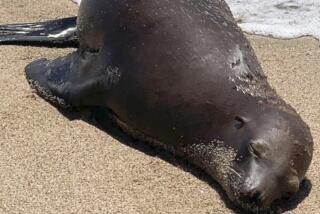Seals’ Fate May Be Sealed
- Share via
Bob Heiney makes his living off fishermen, but he has a soft spot for two of their greatest nemeses--sea lions and seals.
Heiney, 32, of Oxnard runs Cisco’s Sportfishing in Channel Islands Harbor, and almost every day as many as five seals gather to grab a piece of chum that might have slipped out of the bait tank. The animals don’t cause much of a problem for Heiney, but to some fishermen, they are nothing but trouble.
“Would some fishermen shoot them if it was allowed by law? You bet,” Heiney said.
Jerry Barker, 47, a longtime local fisherman, said the seals and sea lions can be a big headache at sea. “They steal fish right off the line. It’s a continuing problem,” Barker said.
In the waters off Ventura County, California sea lions and Pacific harbor seals have been known to destroy expensive nets to get at schools of fish. And federal officials say that in some marinas, aggressive animals may pose a threat to public safety.
In fact, the two species of seals and sea lions have interfered with fishing operations and damaged private property to such an extent that the National Marine Fisheries Service is recommending that Congress lift a 3-year-old ban on killing them. Fishermen would be allowed to shoot the creatures if repeated attempts to drive them away fail.
The federal agency recommended lifting the ban in a March 27 report to Congress. It is now circulating the report to other government agencies and fishermen, and collecting public comment on the proposal through June.
The comments will be added to a final report to be released about three months later. To lift the ban, Congress would have to vote to amend the Marine Mammal Protection Act.
Pacific harbor seals and California sea lions have been protected since 1972, when the act was passed.
Commercial fishermen were allowed to kill the animals if they became a problem until the practice was banned in 1994. But the ban hasn’t stopped frustrated fishermen from shooting animals. About 30 are injured or killed by gunshots each year in the state, according to Joe Cordaro, a National Marine Fisheries Service wildlife biologist.
Paul Ortiz, senior enforcement attorney for the National Oceanic and Atmospheric Administration, said prosecutions of people who injure or kill a marine mammal are rare. “You need an eyewitness, or a dead animal,” he said.
In 1996, the captain of a Long Beach charter boat was fined $3,000 and ordered to spend 30 days in a federal penitentiary after he shot a seal in the presence of undercover officers.
Commercial as well as sportfishing operations are affected by the voracious creatures, whose numbers are growing by about 5% each year, according to the marine fisheries agency’s report to Congress. The agency estimates that there are more than 161,000 California sea lions and 76,000 harbor seals off the West Coast.
Tony West, co-director of the Ventura-based Federation of Independent Seafood Harvesters, said the animals have forced fishermen to give up fishing in certain areas. In other areas, the loss of fish to seals and sea lions can be as high as 60%, West said.
He said the sea lions often scare away other fish while diving into commercial nets during the night. He said the shaking causes the net to light up--a phenomenon known as “fire in the water.”
“When the net lights up, that scares the fish away. If you can’t shake the sea lions, you’re in trouble. The whole night can be a total loss,” West said.
Heiney said he understands the fishermen’s frustration, but he questions whether killing the animals is the best way to deal with the problem.
“I know some people would like to blow their heads off if they could. But I think that’s wrong. I wouldn’t do it,” Heiney said.
Barker, who sometimes helps out at Ventura Sportfishing in Ventura Harbor, said the seals and sea lions know the dock is the place to be for fish.
“They’re over here all the time messing with the bait tank. They’re eating the bait, chewing up the bait nets and harassing the fishermen off the pay dock,” Barker said.
According to National Marine Fisheries Service officials, the animals, popular with whale-watching tourists, are consuming 217,000 metric tons of fish and shellfish every year.
Until nonlethal methods are developed to drive the animals away, officials say they will probably lift the ban.
But marine mammal advocates vow to fight it, saying that killing the animals is not a viable option.
“I know these men are trying to make a living. But the sea lions aren’t responsible for the declining number of fish in the ocean. They’re not the creature with the options. We’re the creature with the options,” said Dan Pearson, president of the nonprofit Point Mugu Wildlife Center. The private group cares for injured marine mammals on land leased by the Navy, but is not affiliated with the Navy.
Each year between March and July, the center cares for about three seals and sea lions that have been shot, according to Pearson. “There are options to shooting marine mammals in fish nets,” he said.
Pearson said there needs to be more money for development of nonlethal methods, including devices that emit sound waves to scare off the animals.
Alan Godley, founder and director of the Carpinteria-based Blue Dolphin Alliance, said in no case should an animal be killed. He suggested tranquilizing the problem animals, and relocating them to a facility where they can be used for research or entertainment.
“This could get really out of control. There’s no way to monitor it,” Godley said. “If they’re going to have to take the animal out, use it in a sea life park, or an animal training facility.”
The animals are clever, and know how to seek out an easy meal. Efforts to drive them away from boats and bait tanks work for a short time, and then have little effect, government officials and fisherman say.
“Some of these things have the opposite effect, acting more like a dinner bell than something that’s supposed to scare them off,” West said.
In the past, there were no restrictions on the shooting.
“There was never rampant killing. They’re hard to get. If you got one, you were lucky,” West said.
Faced with declining herds and outcry from animal activists, the federal government banned the killings in 1994, sending the fishing industry scrambling for a way to deter the fish-gorging animals.
“We had what was called the seal bomb. It was actually made for the duck industry in the Sacramento Delta area” to scare away ducks that were feasting on rice, West said.
The cherry-bomb-like devices were used by fishermen because they were waterproof and exploded underwater. The bombs work the first few times, but the animals eventually learned to live with the blasts.
Among the other techniques being used is taste aversion, in which bait is tainted with nonlethal lithium chloride, a substance that makes the animal regurgitate the fish.
“The feds are going to have to realize the importance of nonlethal methods. But, in certain cases, with certain animals, I think killing them is going to be the only alternative,” said Bob Fletcher, chairman of the Pacific Fishery Management Council.
In the early 1980s, problems with sea lions were the exception; now they are the rule, he said.
“In the last 10 to 15 years, the populations have gotten to a level that the animals are fighting for the food. They have been forced out of prime feeding areas and are looking for new food sources,” Fletcher said.
Fletcher, who also is president of the Sportfishing Assn. of California, said one of the best sources of food are the sportfishing boats that operate out of harbors and marinas up and down the coast.
“Here’s how it works. The boat drops anchor and a handful of live bait is thrown in the water. Over time, that chum swims down current and brings the game fish following the chum line back to the boat. Now, the minute the chum is dropped, the chain and the anchor call the seals and sea lions to dinner,” Fletcher said.
“They have learned to be very opportunistic as to what they take.”
A favorite is the Pacific barracuda. Unfortunately, the barracuda is one of the most popular with sportfisherman. The animals also enjoy yellowtail, and since landing one can take as long as 40 minutes, there’s ample time for the sea lion to grab it from the sportfisherman, Fletcher said.
Fletcher said a relatively small percentage of the animals cause most of the problems for fishermen.
“If we could remove a few of the real problem animals, then we can condition these animals to stay away from our boats,” he said.
Like Pearson, Fletcher said there needs to be more money spent on the development of nonlethal deterrents.
“We don’t want to reduce the population. But we want good science to help us find a solution,” Fletcher said.
(BEGIN TEXT OF INFOBOX / INFOGRAPHIC)
FYI
To obtain a copy of the report or submit your comments, write to: Regional Administrator, NMFS Northwest Region, 7600 Sand Point Way N.E., BIN C15700, Seattle, WA 98115.
More to Read
Sign up for Essential California
The most important California stories and recommendations in your inbox every morning.
You may occasionally receive promotional content from the Los Angeles Times.










